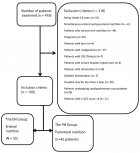Abstract
Review Article
A Update on Brachytherapy for Cervical Cancer: A Review
Arjun Moorthy, Ayan Issac, Ngoc-Anh Le, Kavin Mutyala*, Bhuvi Mamtani, Shyamal Patel and Lyndsay Willmott
Published: 31 October, 2025 | Volume 8 - Issue 4 | Pages: 085-091
Introduction: Cervical cancer remains one of the most common malignancies affecting women worldwide, with over 600,000 patients globally every year, and is a leading cause of cancer-related mortality in women. Although there have been advancements in both screening and prevention, radiation therapy, with or without chemotherapy, is the standard of care for treating locally advanced cervical cancer. Radiation typically consists of two methods, external beam radiation therapy (EBRT) and brachytherapy, which have both evolved in their own respective ways technologically and for patient accessibility. This article aims to review the different cervical cancer brachytherapy techniques, such as intracavitary and interstitial approaches, including their advantages and drawbacks.
Methods: Resources on PubMed between the years 2000 and 2024 were reviewed
based on their relevance to the approaches of brachytherapy. Articles were found through the use of key terms and Boolean operators such as ("cervical cancer,” AND “brachytherapy," OR “high dose rate brachytherapy,”) OR (“intracavitary,” OR “interstitial brachytherapy,” OR “hybrid brachytherapy,”).
Discussion: Three techniques of brachytherapy are de: intracavitary brachytherapy (ICBT), interstitial brachytherapy (ISBT), and hybrid intracavitary/interstitial brachytherapy (HBT).
Conclusion: Brachytherapy is a vital part of definitive cervical cancer treatment. While ICBT remains the standard of care for most cervical cancers, ISBT and HBT approaches remain important treatment options. HBT has been shown to address variances in patient anatomy and tumor geometry, resulting in better tumor dose coverage and improved outcomes through minimizing toxicity.
Read Full Article HTML DOI: 10.29328/journal.cjog.1001195 Cite this Article Read Full Article PDF
Keywords:
Cervical cancer; Brachytherapy; Radiation therapy; Image-guided brachytherapy; High-dose-rate brachytherapy; Interstitial brachytherapy; External Beam Radiation Therapy (EBRT); Artificial Intelligence (AI)
References
- Arbyn M, Weiderpass E, Bruni L, de Sanjosé S, Saraiya M, Ferlay J, et al. Estimates of incidence and mortality of cervical cancer in 2018: a worldwide analysis. Lancet Glob Health. 2020;8(2):e191–203. Available from: https://www.thelancet.com/journals/langlo/article/PIIS2214-109X(19)30482-6/fulltext
- Tewari KS. Cervical cancer. N Engl J Med. 2025;392(1):56–71. Available from: https://www.nejm.org/doi/full/10.1056/nejmra2404457
- Chino J, Annunziata CM, Beriwal S, Bradfield L, Erickson BA, Fields EC, et al. Radiation therapy for cervical cancer: executive summary of an ASTRO clinical practice guideline. Pract Radiat Oncol. 2020;10(4):220–34. Available from: https://www.practicalradonc.org/article/S1879-8500(20)30095-8/fulltext
- Huang CC, Ayala-Peacock DN, Stephens SJ, Chino JP. Recent advances in gynecologic radiation oncology. Cancer. 2025;131(9):e35888. Available from: https://acsjournals.onlinelibrary.wiley.com/doi/10.1002/cncr.35888
- Yang X, Ren H, Li Z, Fu J. Brachytherapy for cervical cancer: from intracavitary to interstitial technique. Front Oncol. 2024;14:1442712. Available from: https://www.frontiersin.org/articles/10.3389/fonc.2024.1442712/full
- Banerjee R, Kamrava M. Brachytherapy in the treatment of cervical cancer: a review. Int J Womens Health. 2014;6:555–64. Available from: https://www.dovepress.com/brachytherapy-in-the-treatment-of-cervical-cancer-a-review-peer-reviewed-fulltext-article-IJWH
- Sturdza AE, Knoth J. Image-guided brachytherapy in cervical cancer including fractionation. Int J Gynecol Cancer. 2022;32(3):273–80. Available from: https://www.ncbi.nlm.nih.gov/
- Erickson B, Eifel P, Moughan J, Rownd J, Iarocci T, Owen J. Patterns of brachytherapy practice for patients with carcinoma of the cervix (1996–1999): a patterns of care study. Int J Radiat Oncol Biol Phys. 2005;63(4):1083–92. Available from: https://www.redjournal.org/article/S0360-3016(05)00588-5/fulltext
- Itami J, Murakami N, Watanabe M. Combined interstitial and intracavitary high-dose-rate brachytherapy of cervical cancer. Front Oncol. 2022;11:809825. Available from: https://www.frontiersin.org/articles/10.3389/fonc.2021.809825/full
- Tanderup K, Eifel PJ, Yashar CM, Pötter R, Grigsby PW. Curative radiation therapy for locally advanced cervical cancer: brachytherapy is NOT optional. Int J Radiat Oncol Biol Phys. 2014;88(3):537–9. Available from: https://www.redjournal.org/article/S0360-3016(13)03369-9/fulltext
- Han K, Milosevic M, Fyles A, Pintilie M, Viswanathan AN. Trends in the utilization of brachytherapy in cervical cancer in the United States. Int J Radiat Oncol Biol Phys. 2013;87(1):111–9. Available from: https://www.redjournal.org/article/S0360-3016(13)00667-1/fulltext
- Pötter R, Tanderup K, Schmid MP, Jürgenliemk-Schulz I, Haie-Meder C, Fokdal LU, et al. MRI-guided adaptive brachytherapy in locally advanced cervical cancer (EMBRACE-I): a multicentre prospective cohort study. Lancet Oncol. 2021;22(4):538–47. Available from: https://www.thelancet.com/journals/lanonc/article/PIIS1470-2045(20)30753-1/fulltext
- Eifel PJ, Winter K, Morris M, Levenback C, Grigsby PW, Cooper J, et al. Pelvic irradiation with concurrent chemotherapy versus pelvic and para-aortic irradiation for high-risk cervical cancer: an update of Radiation Therapy Oncology Group trial (RTOG) 90-01. J Clin Oncol. 2004;22(5):872–80. Available from: https://ascopubs.org/doi/10.1200/JCO.2004.07.197
- Tod M, Meredith WJ. Treatment of cancer of the cervix uteri, a revised Manchester method. Br J Radiol. 1953;26(305):252–7. Available from: https://www.birpublications.org/doi/10.1259/0007-1285-26-305-252
- Pötter R, Haie-Meder C, Van Limbergen E, Barillot I, De Brabandere M, Dimopoulos J, et al. Recommendations from gynecological (GYN) GEC ESTRO working group (II): concepts and terms in 3D image-based treatment planning in cervical cancer brachytherapy – 3D dose volume parameters and aspects of 3D image-based anatomy, radiation physics, radiobiology. Radiother Oncol. 2006;78(1):67–77. Available from: https://www.thegreenjournal.com/article/S0167-8140(05)00490-0/fulltext
- Datta NR. From 'points' to 'profiles' in intracavitary brachytherapy of cervical cancer. Curr Opin Obstet Gynecol. 2005;17(1):35–41. Available from: https://journals.lww.com/co-obgyn/Abstract/2005/02000/From__points__to__profiles__in_intracavitary.7.aspx
- Pötter R, Federico M, Sturdza A, Fotina I, Hegazy N, Schmid M, et al. Value of magnetic resonance imaging without or with applicator in place for target definition in cervical cancer brachytherapy. Int J Radiat Oncol Biol Phys. 2016;94(3):588–97. Available from: https://www.redjournal.org/article/S0360-3016(15)03461-7/fulltext
- Ren J, Yuan W, Wang R, Wang Q, Li Y, Xue C, et al. Dosimetric comparison between three-dimensional magnetic resonance imaging-guided and conventional two-dimensional point A-based intracavitary brachytherapy planning for cervical cancer. PLoS One. 2016;11(9):e0161932. Available from: https://journals.plos.org/plosone/article?id=10.1371/journal.pone.0161932
- Serban M, Kirisits C, de Leeuw A, Pötter R, Jürgenliemk-Schulz I, Nesvacil N, et al. Ring versus ovoids and intracavitary versus intracavitary-interstitial applicators in cervical cancer brachytherapy: results from the EMBRACE I study. Int J Radiat Oncol Biol Phys. 2020;106(5):1052–62. Available from: https://www.redjournal.org/article/S0360-3016(19)34159-0/fulltext
- Nath R, Rivard MJ, DeWerd LA, Dezarn WA, Thompson Heaton H 2nd, Ibbott GS, et al. Guidelines by the AAPM and GEC-ESTRO on the use of innovative brachytherapy devices and applications: report of Task Group 167. Med Phys. 2016;43(6):3178–205. Available from: https://aapm.onlinelibrary.wiley.com/doi/10.1118/1.4951734
- Aronowitz JN. Afterloading: the technique that rescued brachytherapy. Int J Radiat Oncol Biol Phys. 2015;92(3):479–87. Available from: https://www.redjournal.org/article/S0360-3016(15)00340-2/fulltext
- Yoshida K, Yamazaki H, Kotsuma T, Takenaka T, Ueda MM, Miyake S, et al. Simulation analysis of optimized brachytherapy for uterine cervical cancer: can we select the best brachytherapy modality depending on tumor size? Brachytherapy. 2016;15(1):57–64. Available from: https://www.brachyjournal.com/article/S1538-4721(15)00429-0/fulltext
- Terahara A, Nakano T, Ishikawa A, Morita S, Tsuji H, et al. Dose-volume histogram analysis of high-dose-rate intracavitary brachytherapy for uterine cervix cancer. Int J Radiat Oncol Biol Phys. 1996;35(3):549–54. Available from: https://www.redjournal.org/article/S0360-3016(96)80018-6/fulltext
- Nag S, Martínez-Monge R, Ellis R, Lewandowski G, Vacarello L, Boutselis JG, et al. The use of fluoroscopy to guide needle placement in interstitial gynecological brachytherapy. Int J Radiat Oncol Biol Phys. 1998;40(2):415–20. Available from: https://www.redjournal.org/article/S0360-3016(97)00719-0/fulltext
- Prisciandaro JI, Zhao X, Dieterich S, Hasan Y, Jolly S, Al-Hallaq HA. Interstitial high-dose-rate gynecologic brachytherapy: clinical workflow experience from three academic institutions. Semin Radiat Oncol. 2020;30(1):29–38. Available from: https://www.sciencedirect.com/science/article/pii/S1053429619300801
- Nag S, Dobelbower R, Glasgow G, Gustafson G, Syed N, Thomadsen B, et al. Inter-society standards for the performance of brachytherapy: a joint report from ABS, ACMP, and ACRO. Crit Rev Oncol Hematol. 2003;48(1):1–17. Available from: https://www.sciencedirect.com/science/article/pii/S104084280300026X
- Pinn-Bingham M, Puthawala AA, Syed AM, Sharma A, Disaia P, Berman M, et al. Outcomes of high-dose-rate interstitial brachytherapy in the treatment of locally advanced cervical cancer: long-term results. Int J Radiat Oncol Biol Phys. 2013;85(3):714–20. Available from: https://www.redjournal.org/article/S0360-3016(12)01125-7/fulltext
- Bansal AK, Semwal MK, Sharma DN, Thulkar S, Julka PK, Rath GK, et al. A patient-based dosimetric study of intracavitary and interstitial brachytherapy in advanced stage carcinoma of the cervix. J Appl Clin Med Phys. 2014;15(5):4509. Available from: https://www.jacmp.org/article/10.1120/jacmp.v15i5.4509
- Recio FO, Piver MS, Hempling RE, Eltabbakh GH, Hahn S. Laparoscopic-assisted application of interstitial brachytherapy for locally advanced cervical carcinoma: results of a pilot study. Int J Radiat Oncol Biol Phys. 1998;40(2):411–4. Available from: https://www.redjournal.org/article/S0360-3016(97)00738-4/fulltext
- Oike T, Ohno T, Noda SE, Kiyohara H, Ando K, Shibuya K, et al. Can a combined intracavitary/interstitial approach be an alternative to interstitial brachytherapy with the Martinez Universal Perineal Interstitial Template (MUPIT) in computed tomography-guided adaptive brachytherapy for bulky and/or irregularly shaped gynecological tumors? Radiat Oncol. 2014;9:222. Available from: https://ro-journal.biomedcentral.com/articles/10.1186/s13014-014-0222-6
- Nomden CN, de Leeuw AA, Moerland MA, Roesink JM, Tersteeg RJ, Jürgenliemk-Schulz IM. Clinical use of the Utrecht applicator for combined intracavitary/interstitial brachytherapy treatment in locally advanced cervical cancer. Int J Radiat Oncol Biol Phys. 2012;82(4):1424–30. Available from: https://www.redjournal.org/article/S0360-3016(11)00592-0/fulltext
- Kirisits C, Lang S, Dimopoulos J, Berger D, Georg D, Pötter R. The Vienna applicator for combined intracavitary and interstitial brachytherapy of cervical cancer: design, application, treatment planning, and dosimetric results. Int J Radiat Oncol Biol Phys. 2006;65(2):624–30. Available from: https://www.redjournal.org/article/S0360-3016(06)00308-1/fulltext
- Murakami N, Kato S, Nakano T, Uno T, Yamanaka T, Sakurai H, et al. A phase I/II clinical trial for the hybrid of intracavitary and interstitial brachytherapy for locally advanced cervical cancer. BMC Cancer. 2016;16:640. Available from: https://bmccancer.biomedcentral.com/articles/10.1186/s12885-016-2543-3
- Murakami N, Kobayashi K, Shima S, Tsuchida K, Kashihara T, Tselis N, et al. A hybrid technique of intracavitary and interstitial brachytherapy for locally advanced cervical cancer: initial outcomes of a single-institute experience. BMC Cancer. 2019;19:221. Available from: https://bmccancer.biomedcentral.com/articles/10.1186/s12885-019-5430-x
- Cordoba A, Gesta E, Escande A, Noeuveglise A, Cayez R, Halty A, et al. Interstitial needles versus intracavitary applicators only for locally advanced cervical cancer: results from real-life dosimetric comparisons. Front Oncol. 2024;14:1347727. Available from: https://www.frontiersin.org/articles/10.3389/fonc.2024.1347727/full
- Le NA, Patel S, Mutyala K, Issac A, Mamtani B, Willmott L. Outpatient hybrid intracavitary-interstitial brachytherapy for cervical cancer with minimal sedation in a freestanding setting. Gynecol Oncol Rep. 2025;59:101767. Available from: https://www.sciencedirect.com/science/article/pii/S2352578925000700
- Mutyala S, Smith G, Ansinelli H, Thawani N. Feasibility of outpatient hybrid brachytherapy for cervical cancer with minimal sedation: results from a single-institutional protocol. J Contemp Brachytherapy. 2023;15(1):43–7. Available from: https://www.termedia.pl/Feasibility-of-outpatient-hybrid-brachytherapy-for-cervical-cancer-with-minimal-sedation-results-from-a-single-institutional-protocol,54,50294,1,1.html
- Bélanger C, Aubin S, Lavallée MC, Beaulieu L. Simultaneous catheter and multicriteria optimization for HDR cervical cancer brachytherapy with a complex intracavity/interstitial applicator. Med Phys. 2024;51(5):2128–43. Available from: https://aapm.onlinelibrary.wiley.com/doi/10.1002/mp.16874
- Varela Cagetti L, Gonzague-Casabianca L, Zemmour C, Lambaudie E, Houvenaeghel G, Provansal M, et al. The impact of modern preoperative high-dose-rate brachytherapy in early-stage cervical cancer. Gynecol Oncol. 2021;161(1):166–72. Available from: https://www.sciencedirect.com/science/article/pii/S0090825821000418
- Arya R, Giurcanu M, Jutzy JM, Peters P, Daily EW, Golden DW, et al. Local control and use of external beam parametrial boost in the era of image-guided brachytherapy for locally advanced cervical cancer. Am J Clin Oncol. 2021;44(11):565–71. Available from: https://journals.lww.com/amjclinicaloncology/Fulltext/2021/11000/Local_Control_and_Use_of_External_Beam_Parametrial.6.aspx
- Syed AM, Puthawala AA, Abdelaziz NN, el-Naggar M, Disaia P, Berman M, et al. Long-term results of low-dose-rate interstitial-intracavitary brachytherapy in the treatment of carcinoma of the cervix. Int J Radiat Oncol Biol Phys. 2002;54(1):67–78. Available from: https://www.redjournal.org/article/S0360-3016(02)02900-0/fulltext
- Viswanathan AN, Beriwal S, De Los Santos JF, Demanes DJ, Gaffney D, Hansen J, et al. American Brachytherapy Society consensus guidelines for locally advanced carcinoma of the cervix. Part II: high-dose-rate brachytherapy. Brachytherapy. 2012;11(1):47–52. Available from: https://www.brachyjournal.com/article/S1538-4721(11)00321-5/fulltext
- Demanes DJ, Rodriguez RR, Bendre DD, Ewing TL. High dose rate transperineal interstitial brachytherapy for cervical cancer: high pelvic control and low complication rates. Int J Radiat Oncol Biol Phys. 1999;45(1):105–12. Available from: https://www.redjournal.org/article/S0360-3016(99)00124-8/fulltext
- Schwarz JK, Beriwal S, Esthappan J, Erickson B, Feltmate C, Fyles A, et al. Consensus statement for brachytherapy for the treatment of medically inoperable endometrial cancer. Brachytherapy. 2015;14(5):587–99. Available from: https://www.brachyjournal.com/article/S1538-4721(15)00216-1/fulltext
- Ka K, Laville A, Rassy E, El Ayachi R, Pautier P, Ba MB, et al. Image-guided adaptive brachytherapy for advanced cervical cancer spreading to the bladder and/or rectum: clinical outcome and prognostic factors. Gynecol Oncol. 2023;168:32–8. Available from: https://www.sciencedirect.com/science/article/pii/S0090825822007284
- Callaghan CM, Adams Q, Flynn RT, Wu X, Xu W, Kim Y. Systematic review of intensity-modulated brachytherapy (IMBT): static and dynamic techniques. Int J Radiat Oncol Biol Phys. 2019;105(1):206–21. Available from: https://www.redjournal.org/article/S0360-3016(19)30977-3/fulltext
- Welsh JS, Limmer JP, Howard SP, Diamond D, Harari PM, Tome W. Precautions in the use of intensity-modulated radiation therapy. Technol Cancer Res Treat. 2005;4(2):203–10. Available from: https://journals.sagepub.com/doi/10.1177/153303460500400209
- Soror T, Siebert FA, Lancellotta V, Placidi E, Fionda B, Tagliaferri L, et al. Quality assurance in modern gynecological HDR-brachytherapy (interventional radiotherapy): clinical considerations and comments. Cancers (Basel). 2021;13(4):912. Available from: https://www.mdpi.com/2072-6694/13/4/912
- Prisciandaro J, Zoberi JE, Cohen G, Kim Y, Johnson P, Paulson E, et al. AAPM task group report 303 endorsed by the ABS: MRI implementation in HDR brachytherapy—considerations from simulation to treatment. Med Phys. 2022;49(8):e983–1023. Available from: https://aapm.onlinelibrary.wiley.com/doi/10.1002/mp.15713
- Shi J, Chen J, He G, Peng Q. Artificial intelligence in high-dose-rate brachytherapy treatment planning for cervical cancer: a review. Front Oncol. 2025;15:1507592. Available from: https://www.frontiersin.org/articles/10.3389/fonc.2025.1507592/full
Figures:
Similar Articles
-
Triple negative breast cancer: Early stages management and evolution, a two years experience at the department of breast cancer of CHSFBouzid Nassima,Darido Jessie*,Diari Jed,Dussour Chloe,Ezenfis Joel,Cahn Virginie,Guekeu Steven,Rigonnot Luc. Triple negative breast cancer: Early stages management and evolution, a two years experience at the department of breast cancer of CHSF. . 2020 doi: 10.29328/journal.cjog.1001052; 3: 065-078
-
Cervical Cancer and Quality of Life: Systematic ReviewLuísa Soares*, Sofia Abreu Dantas. Cervical Cancer and Quality of Life: Systematic Review. . 2024 doi: 10.29328/journal.cjog.1001158; 7: 017-024
-
Pattern of LRR in Endometrial Cancer and Identification of Predictive FactorsAlia Mousli, Mohamed Aziz Cherif*, Marouen Benna, Ameni Yousfi, Semia Zaraa, Rim Abidi, Chiraz Nasr. Pattern of LRR in Endometrial Cancer and Identification of Predictive Factors. . 2024 doi: 10.29328/journal.cjog.1001169; 7: 078-083
-
A Update on Brachytherapy for Cervical Cancer: A ReviewArjun Moorthy,Ayan Issac,Ngoc-Anh Le,Kavin Mutyala*,Bhuvi Mamtani,Shyamal Patel,Lyndsay Willmott. A Update on Brachytherapy for Cervical Cancer: A Review. . 2025 doi: 10.29328/journal.cjog.1001195; 8: 085-091
Recently Viewed
-
Peripartum Cardiomyopathy: Early Diagnosis and Management in Secondary Care HospitalSukanya Nagsen Thorat*,Abhyudai Ravooru. Peripartum Cardiomyopathy: Early Diagnosis and Management in Secondary Care Hospital. Clin J Obstet Gynecol. 2025: doi: 10.29328/journal.cjog.1001194; 8: 082-084
-
Relationship between Particle Size, Anti-Microbial Activity and Leachability of Copper Particles in Liquid Suspension and Compounded in PolypropyleneSaleh Alkarri*, Jérôme Vachon. Relationship between Particle Size, Anti-Microbial Activity and Leachability of Copper Particles in Liquid Suspension and Compounded in Polypropylene. Ann Biomed Sci Eng. 2024: doi: 10.29328/journal.abse.1001030; 8: 021-031
-
Anesthetic Management of a Patient with Left Ventricular Thrombus Posted for Emergency LaparotomyArpita Das*. Anesthetic Management of a Patient with Left Ventricular Thrombus Posted for Emergency Laparotomy. Int J Clin Anesth Res. 2025: doi: 10.29328/journal.ijcar.1001028; 9: 013-016
-
Anesthesia mumps: a case reportMaher Al-Hajjaj*,Anfal Salim,Mahmoud Mohammad,Maab Mohamed,Ahmad Tawosh,Ababca Fatima Zohra. Anesthesia mumps: a case report. Int J Clin Anesth Res. 2023: doi: 10.29328/journal.ijcar.1001022; 7: 006-007
-
Scrolling Towards Stress: The Negative Influence of Mobile Reels on Hypertensive HealthMuhammad Mudasir Atif*. Scrolling Towards Stress: The Negative Influence of Mobile Reels on Hypertensive Health. J Community Med Health Solut. 2025: doi: 10.29328/journal.jcmhs.1001057; 6: 048-049
Most Viewed
-
Feasibility study of magnetic sensing for detecting single-neuron action potentialsDenis Tonini,Kai Wu,Renata Saha,Jian-Ping Wang*. Feasibility study of magnetic sensing for detecting single-neuron action potentials. Ann Biomed Sci Eng. 2022 doi: 10.29328/journal.abse.1001018; 6: 019-029
-
Evaluation of In vitro and Ex vivo Models for Studying the Effectiveness of Vaginal Drug Systems in Controlling Microbe Infections: A Systematic ReviewMohammad Hossein Karami*, Majid Abdouss*, Mandana Karami. Evaluation of In vitro and Ex vivo Models for Studying the Effectiveness of Vaginal Drug Systems in Controlling Microbe Infections: A Systematic Review. Clin J Obstet Gynecol. 2023 doi: 10.29328/journal.cjog.1001151; 6: 201-215
-
Causal Link between Human Blood Metabolites and Asthma: An Investigation Using Mendelian RandomizationYong-Qing Zhu, Xiao-Yan Meng, Jing-Hua Yang*. Causal Link between Human Blood Metabolites and Asthma: An Investigation Using Mendelian Randomization. Arch Asthma Allergy Immunol. 2023 doi: 10.29328/journal.aaai.1001032; 7: 012-022
-
An algorithm to safely manage oral food challenge in an office-based setting for children with multiple food allergiesNathalie Cottel,Aïcha Dieme,Véronique Orcel,Yannick Chantran,Mélisande Bourgoin-Heck,Jocelyne Just. An algorithm to safely manage oral food challenge in an office-based setting for children with multiple food allergies. Arch Asthma Allergy Immunol. 2021 doi: 10.29328/journal.aaai.1001027; 5: 030-037
-
Impact of Latex Sensitization on Asthma and Rhinitis Progression: A Study at Abidjan-Cocody University Hospital - Côte d’Ivoire (Progression of Asthma and Rhinitis related to Latex Sensitization)Dasse Sery Romuald*, KL Siransy, N Koffi, RO Yeboah, EK Nguessan, HA Adou, VP Goran-Kouacou, AU Assi, JY Seri, S Moussa, D Oura, CL Memel, H Koya, E Atoukoula. Impact of Latex Sensitization on Asthma and Rhinitis Progression: A Study at Abidjan-Cocody University Hospital - Côte d’Ivoire (Progression of Asthma and Rhinitis related to Latex Sensitization). Arch Asthma Allergy Immunol. 2024 doi: 10.29328/journal.aaai.1001035; 8: 007-012

If you are already a member of our network and need to keep track of any developments regarding a question you have already submitted, click "take me to my Query."
















































































































































